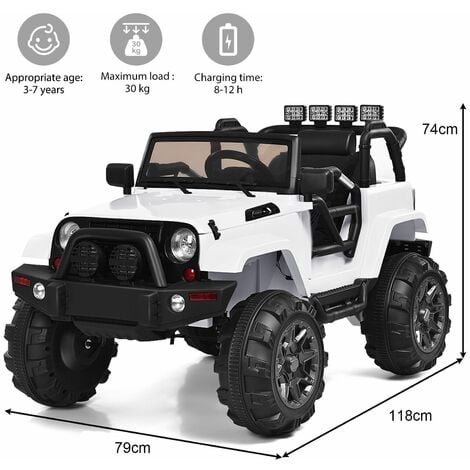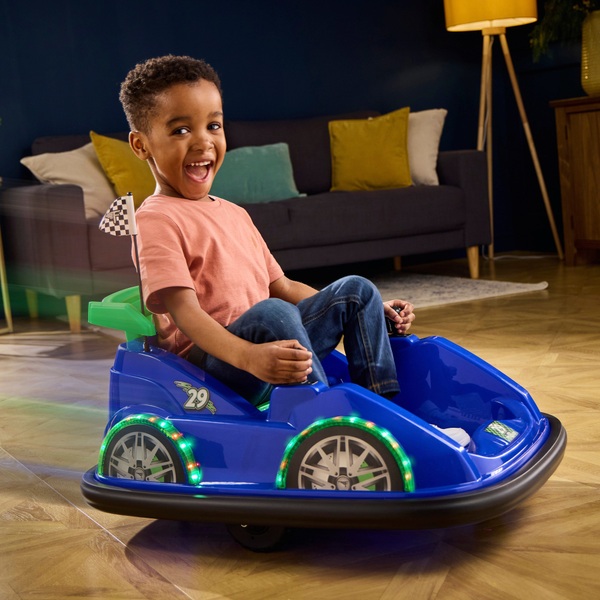Free Reasons For Selecting Remote Control Childrens Cars
Free Reasons For Selecting Remote Control Childrens Cars
Blog Article
What Ride-On Car Safety Features Should I Consider? The Pros And The Negatives
It is important that you think about safety features when you are choosing the best car for your children. They will help keep them safe and happy while playing. Seat Belts, for example are a security measure which is essential to think about.
Pros - Seatbelts keep your child inside the vehicle they ride on, which reduces the chance of them falling out or being kicked out during play. Seat belts provide an additional layer of protection for your child from sudden turns and sudden stops.
Pros - Some cars on wheels might not come with seat belts. This is particularly applicable to those designed for children. Kids may also find seat belts to restrict their mobility or uncomfortable which can cause them to reject or avoid using them.
Sturdy Construction
Pros - A vehicle made from high-quality materials and sturdy construction will be more durable and resistant to damage. It will also provide long-term reliability and safety. It is able to withstand the challenges of playing and offer stability.
Cons - Strong construction usually costs more at a higher level, which makes it more costly for some families. Ride-on vehicles may be less maneuverable and portable when they're made from heavier materials.
The Low Center of Gravity -
Pros- Ride-ons with an elongated center of gravity will be less likely to tip, thus reducing the likelihood of accidents. They offer greater stability and better balance, especially in turning and maneuvers.
Cons - Some cars with low centers of gravity can sacrifice their off-road ability or their ground clearance. This can limit their use in some environments.
Remote Control for Parents -
Pros: Remote-controlled ride-on cars allow parents to supervise, help and supervise their children's play. They also provide a higher degree of security and parental control. Parents can intervene in order to prevent accidents, navigate around difficult terrain, and assist their child in an emergency situation.
Cons Parents who control their children's remotes can limit the autonomy and independence of children as they are dependent on parental assistance and supervision when playing. Furthermore, remote-controlled models can be more expensive than traditional ride-on cars that require manual operation.
Speed Limiters Speed Limiters
Pros - Ride-on cars equipped with speed limiters or variable speed settings allow parents to control the maximum speed of the car and reduce the chance of accidents or collisions. They can also increase the maximum speed when their child's confidence grows.
Cons - Some kids might become bored with the lower speeds rapidly, which can cause disappointment and frustration. Speed limiters aren't always included on all models or they might require additional features or accessories.
Safe Start Technology -
Pros The Safe Start Technology makes sure that the ride-on cars start and stop smoothly. This minimizes the chance of sudden jerks, which could destabilize or startle the child. It provides a safer and more comfortable ride.
Cons: Ride-on vehicles equipped with safety start could cost more than standard cars. Furthermore, some kids may discover that a gradual acceleration and deceleration are not as enjoyable or thrilling than instant starting and stopping.
Visibility Enhancements
Pros - Ride-on vehicles that have visibility enhancements, like working taillights, headlights, or reflective materials improve visibility, especially in low-light conditions or in dimly lit areas. They enhance safety by increasing the visibility of cars to pedestrians and other vehicles.
Cons - Visibility improvements could make batteries less efficient or complicate ride-on vehicles' designs, increasing maintenance or malfunction risks.
When you think about these safety features and weigh the pros, you will be able to select one that is focused on the safety of your child while offering them a fun and exciting playing experience. View the top rated Audi ride on car for more advice including toy in car, toy ride, childrens electric cars, ride a toy, childs ride on car, toy with car, electric ride along car, electric ride on, toy car toy car, electric rideons and more. . 
How Do You Care For And Assemble A Kid's Ride-On Car?
To ensure durability and safety To ensure safety and durability, the majority of ride-on cars for kids require assembly. Here are the assembly and maintenance requirements for children's rides on cars.
The majority of ride-on cars arrive an unassembled state and must be assembled on arrival. This usually involves attaching parts like the steering wheel and seats according to manufacturer's instructions.
Follow the steps to assembly in order to ensure that all components are correctly aligned and attached. Make use of the equipment and tools according to the instructions to complete the assembly process.
Cleaning -
Regular cleaning is necessary to keep the ride-on car running at its peak and performing properly. Use a soft, damp cloth using mild soap and water to clean exterior surfaces.
Pay special attention to areas prone to buildup, such as the tires, wheels, and undercarriage. To remove the grime and dirt that is difficult to remove make use of a toothbrush or brush to access areas that are hard to reach.
Avoid using harsh chemicals, abrasive cleaners, or high-pressure water sprays as these may cause damage to the paint or electronic parts of the ride-on vehicle.
Battery Care -
Battery care is crucial if the ride-on is powered by rechargeable batteries. Proper battery care ensures performance and extend the battery's lifespan. Follow these guidelines to take care of your battery -
The battery must be fully charged prior to the first use, and then following each use to ensure the longest runtime possible.
Beware of overcharging the battery or leaving the battery hooked to the charger for extended periods, as this can harm the battery and shorten its lifespan.
When not in use, keep the battery and ride-on cars in an area that is dry, cool, and away from intense temperatures and direct sunlight.
Check the battery terminals periodically for corrosion or damage. Clean them when needed by using an electric wirebrush or terminal cleaner.
Replace the battery if it isn't holding any charge or displays evidence of being damaged or degraded.
Tire Maintenance -
Regularly check your tires for signs of wear, damage or loss of air. Utilize a bicycle compressor, or an air compressor to fill the tires to the pressure recommended by the manufacturer.
The tread pattern must be examined for foreign objects, debris or other obstructions that can cause flats. Repair or replace damaged tires by removing any obstructions.
Lubricate the axles, wheel bearings, as well as other components to ensure smooth and efficient rotation.
Periodic repairs and replacements
Even with regular maintenance, ride-on vehicles could require repairs on occasion or replacement parts due to wear and tear or damage caused by accident.
Pay attention to signs of malfunction and deterioration such as abnormal noises, loss of power, or erratic behaviors. Refer to the manufacturer's specifications or call customer support for assistance on troubleshooting and repair options.
Replace worn or damaged parts as soon possible to prevent further damages and to make sure that the car is safe for those riding on car.
These instructions for maintenance and assembly will help you keep your child's car ride in good condition so that they can enjoy safely and have fun. Read the most popular find out more on Audi ride on car for more examples including childrens electric ride on, electric rideons, childrens electric cars, a toy car, kids electric cars, digger ride, toy car, cars pedal car, race car toy, toy cars and more. . 
What Types Of Childrens Remote Controlled Cars Are On The Market? What Are The Pros And Cons?
Remote control children's cars, also known as RC cars or remote-controlled automobiles, come in various dimensions and styles as well as prices to meet various budgets and preferences. This article will give you an overview of the types, sizes and prices of children's remote control cars and their advantages and disadvantages.
Electric RC Cars – Battery-powered remote-controlled cars that are suitable for indoor or outdoor use. They are available in various styles like buggies, trucks and sports cars.
Nitro RC Cars : Gas-powered vehicles that are controlled remotely and offer better performance, but require more maintenance. They tend to be larger and cost more than electric RC cars.
Scale Models (Remote-controlled replicas) - These are miniatures of real-life vehicles such as planes, trucks, or cars. Scale models can be found in a variety of scales ranging from 1-10 up to 1-24. The larger scales provide greater detail and realism.
Sizes -
Remote-controlled children's car models come in different sizes. They range from tiny micro-sized copies to large-scale replicas. The size of the car will impact its speed, performance and the handling capabilities.
Micro-sized cars are small and light, which makes them suitable for indoor use and younger children. Larger-scale models offer more power and endurance which makes them suitable for outdoor racing and off-road driving.
Prices
The cost of a remote-controlled car for kids varies based on the dimensions, features, manufacturer, and the build quality.
Small electric vehicles can be bought for between $20 and $100 bigger electric and nitro-powered RCs can cost between $100 and $500 or more.
The price of scale models and hobby grade RC vehicles can range from a few hundred dollars to over 1,000 dollars based on the level of performance and precision.
Pros & Cons
Pros -
Remote Control Cars for Children - These vehicles are fantastic for entertainment. They are able to be utilized by both children and adults.
Development of skills Learning to drive an RC vehicle helps children to improve their spatial awareness as well as hand-eye co-ordination.
Social interaction. You can go on the RC cars with your loved ones and family that encourage social interaction.
Aftermarket parts such as upgrades, accessories, and other items from the aftermarket are a great way to personalize many RC vehicles and enhance their performance.
Cons
Costs - Quality remote control children's vehicles can be costly particularly those with hobby-grade advanced features.
Children may find it difficult to control the RC cars for the first time.
Maintenance - RC vehicles require regular maintenance, which includes cleaning, lubrication, and occasional repairs or replacements of parts.
Safety concerns - RC safety of cars can be impacted due to electrical hazards, collisions and other hazards when the vehicles aren't controlled and used with caution by an adult.
In general, remote-control children's vehicles provide a thrilling and educational experience for children of all ages. However, when deciding on the model that's right for your child, take into consideration factors like price size, dimensions, features and security. For older children, hobby grade RC car models may be a better choice. However, more basic models are also suitable for children who are younger. See the recommended remote control childrens cars kidscars.co.uk news for site recommendations including digger ride, remote control childrens car, ride on car, car toy toy, digger ride, childrens electric cars, ride ons, remote control childrens car, toy a car, kidscars and more. .